Project by: Mariah Langlois
I was attracted to this print primarily because the ambiguous shadowy figure is quite enticing. I was also drawn to it because of the use of text which I think is a fantastic way to direct the viewer towards a more specific interpretation of the work. This print is titled “Let’s Talk” and was created by Adrian Piper, printed in 1992. It is approximately 20.5 inches by 14 inches in size, and the material is a 5-color screenprint on paper. This edition is 52/100. The original piece upon which the screen print was created was oil crayon on gelatin silver print. “Let’s Talk” embodies Adrian Piper’s relationship with race, gender, and identity through artistic expression.
Before going into the details of the print, let’s talk about Adrian Piper and the historical context of when it was made. Piper’s background has a significant impact on her work. She was born in 1948 and grew up in Washington Heights in a middle-class family with a complex racial background. She describes herself as “mixed, like all Americans’’ with a father “having a mixed heritage derived from white and light-skinned black property owners, and… her mother as descending from planter-class Jamaican immigrants…1/32 Malagasy (Madagascar), 1/32 African of unknown origin, 1/16 Igbo (Nigeria), and 1/8 East Indian (Chittagong, India (now Bangladesh)), in addition to having predominantly British and German family ancestry”. She ascribes her unwavering confidence as an artist, even as she experienced racist and sexist discrimination, to her supportive and devoted upbringing. Piper writes, “(I) grew up physically inviolate, unable even to imagine the possibility of a breach to my physical integrity” and states “I do not need your help. I was loved.” The following quote from her biography on her website describes her as an artist:
“Adrian Piper, still producing art today, creates artwork in a variety of traditional and nontraditional media, including photo-text collage, drawing on pre-printed paper, video installation, site-specific sculptural installation, digital imagery, performance and sound works. Piper’s works locate the viewer in a direct, unmediated and indexical relation to the concrete specificity of the object of awareness. They consistently explore the nature of subjecthood and agency, the limits of the self, and the continuities and discontinuities of individual identity in the metaphysical, social and political contexts.”
In the 1970s, the country was divided by a conservative backlash against the social movements of the 60s, influenced by the sentiment that the government was coddling poor people and people of color at the expense of taxpayers. Of course, on the other side was the idea that the social movements of the 60s needed to continue, expand, and evolve. Several significant movements were occurring in the late 60s and early 70s, but with respect to Adrian Piper and her work, the most significant movements were the civil rights movement and the feminist movement.
“Let’s Talk” closely relates to these movements and Piper’s position on these matters. The version that is in Lehigh’s collection is a silkscreen print reproduction of an earlier one of her projects. The print was created for a museum portfolio in 1992. The Bucknell University Samek Art Museum Collection has a separate edition of the portfolio and explains its curation and context of its development:
“Seeking a space to present new political art in a non-commercial context, artists formed the Alternative Museum in New York in 1975. Many of these artists were outspoken critics of government and social institutions. One way for the state to answer these critics was to reduce public funding for the arts in an exchange that became emblematic of the ‘culture wars’ of the 1980s. To offset this reduced funding, in 1992 10 artists produced prints and bundled them into a portfolio that was sold to support the Alternative Museum.”
The portfolio was called “10: Artist as Catalyst”, to address contemporary humanitarian issues by representing the artist as a social critic and catalyst for social change through their work. “Let’s Talk” was re-issued as a screen print for this portfolio because of its expressive criticism of the juxtaposition of internal expectations and external perceptions. Originally part of Adrian Piper’s series “The Mythic Being”, this particular print was part of 6 altered black-and-white photographs of a seated figure smoking a cigarette, captioned sequentially with the following lines: “Let’s have a talk / to bring us closer / as close friends do: / come nearer; may I stroke your back?” As an example of Piper’s larger conceptual-based artistic practice, this image concerns the power of stereotypes and how outwardly visible markers of identity (such as skin color and hairstyle) impact others’ perceptions of our character. The series was a video, photo, and drawing documentation of Piper roaming the streets of NYC between 1973 and 1975 reciting quotes from her teenage journal. She dressed as a working-class black man by wearing masculine clothes, a large afro, a fake mustache, and sunglasses. By completely changing her visual appearance but remaining true to her being by reciting her journal quotes, she explored the conflicting nature of personal identity and societal constraints. Her alter-ego as the ‘mythic being’ deliberately embodied a marginalized, outsider position, which drew attention to the difficulties faced by people who share those aspects of identity in their everyday life. However, as a rather light-skinned person of color, appearing to be male, Piper felt a significant sense of freedom in the way she could act that as a woman of color was unacceptable. In her account of the series, she described the mythic being as a “paradoxical figure of liberation”. Piper elaborated on this in a description of her behavior, writing, “I swagger, stride, lope, lower my eyebrows, raise my shoulders, sit with my legs wide apart on the subway”. This series highlights the limited behavioral bounds society imposed on women, particularly African American women, and her personal experience with the perception of outsiders judging her gender and her race particularly pervasive during the 1970s.
The concept of the ‘new woman’ in art preceded Piper’s career but certainly influenced her subject matter and processes. As women (slowly) began to gain increasing levels of autonomy, personal liberty, and overall resiliency in their everyday lives, they also gained artistic freedom. The ‘new woman’ shattered the glass ceiling in the art world and can be most evidently seen through the shift in the artwork from women as the object to women as the subject. The development of the ‘new woman’ in art allowed Adrian Piper the faculty to produce highly experimental art and be unapologetic about her creations. Her work, and this print, criticize the restrictions burdening women. Although conditions have improved, Piper sheds light on new challenges and restraints that have evolved amid the changing social mores.
Bibliography:
“10: Artist as Catalyst.” Samek Art Museum. Bucknell University, 2020. http://museum.bucknell.edu/2019/09/10/upcoming-10-artist-as-catalyst/.
“28 Art Minute: Adrian, Piper Let’s Talk from ‘10: Artist as Catalyst.’” The Toledo Museum of Art. The Toledo Museum of Art, September 28, 2020. https://www.toledomuseum.org/art/artminute/28-art-minute-adrian-piper-lets-talk-10-artist-catalyst.
Adrian Piper, American, b. 1948. 1992. Let’s Talk. Print. Place: Lehigh University Art Galleries, Bethlehem, Pennsylvania, USA. For more information, contact us at LUAG@Lehigh.edu. https://library.artstor.org/asset/24691820.
“Biography.” Adrian Piper Research Archive: Biography. APRAF Berlin. Accessed October 15, 2020. http://www.adrianpiper.com/biography.shtml.
Lesso, Rosie. “Adrian Piper Artworks & Famous Paintings.” Edited by Lewis Church. The Art Story. TheArtStory.org, June 5, 2019. https://www.theartstory.org/artist/piper-adrian/artworks/.
Lesso, Rosie. “Adrian Piper Paintings, Bio, Ideas.” Edited by Lewis Church. The Art Story. TheArtStory.org, June 5, 2019. https://www.theartstory.org/artist/piper-adrian/.
Image citations:
Adrian Piper, American, b. 1948. 1992. Let’s Talk. Print. Place: Lehigh University Art Galleries, Bethlehem, Pennsylvania, USA. For more information, contact us at LUAG@Lehigh.edu. https://library.artstor.org/asset/24691820.
Bowles, John P. ““Acting like a Man”: Adrian Piper’s Mythic Being and Black Feminism in the 1970s.” Signs 32, no. 3 (2007): 621-47. Accessed October 21, 2020. doi:10.1086/510921.
Note: Unfortunately, I did not get a response in time about Lehigh’s acquisition of the print.
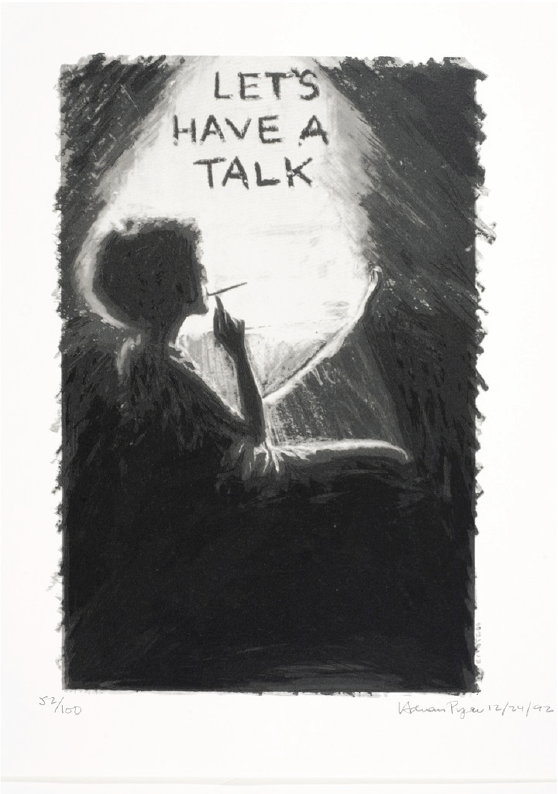
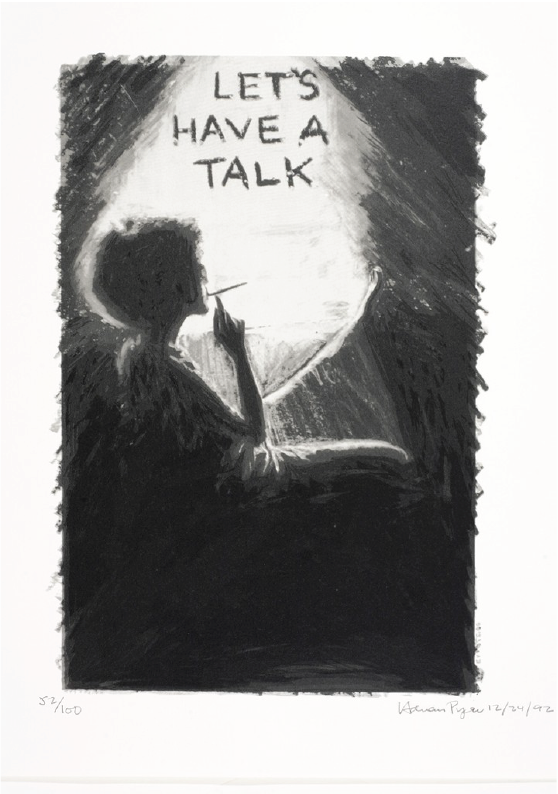
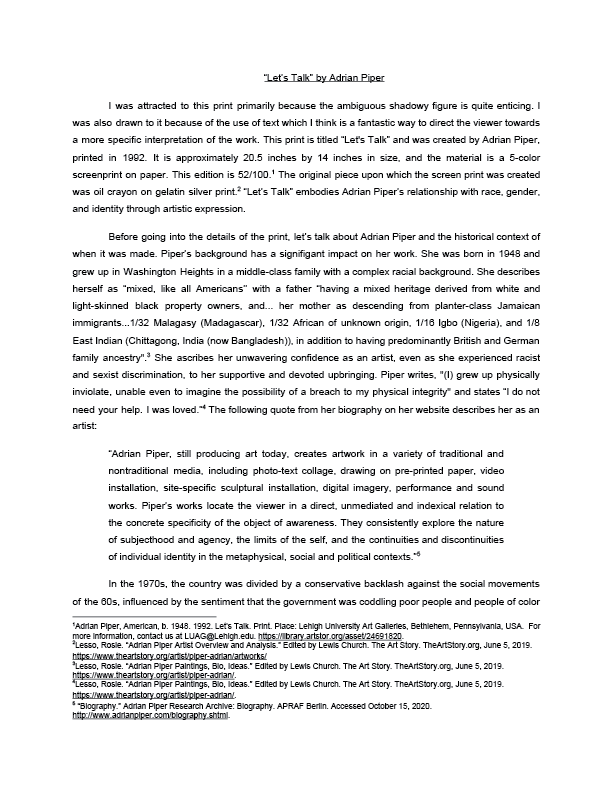

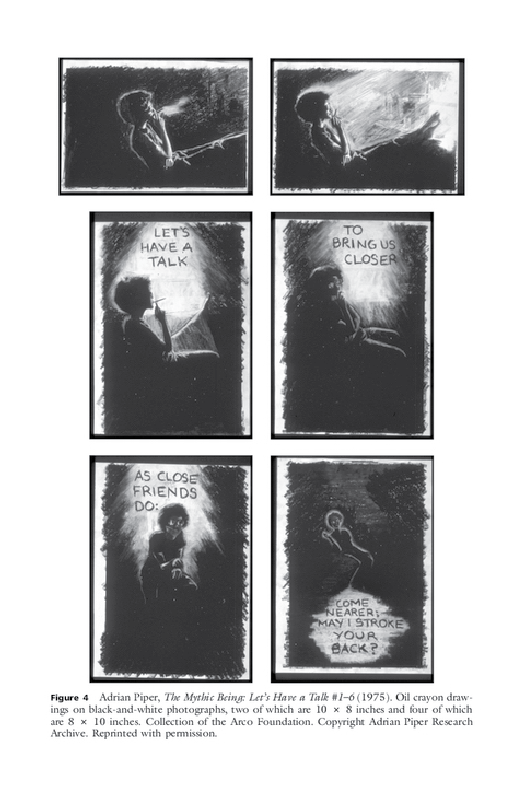
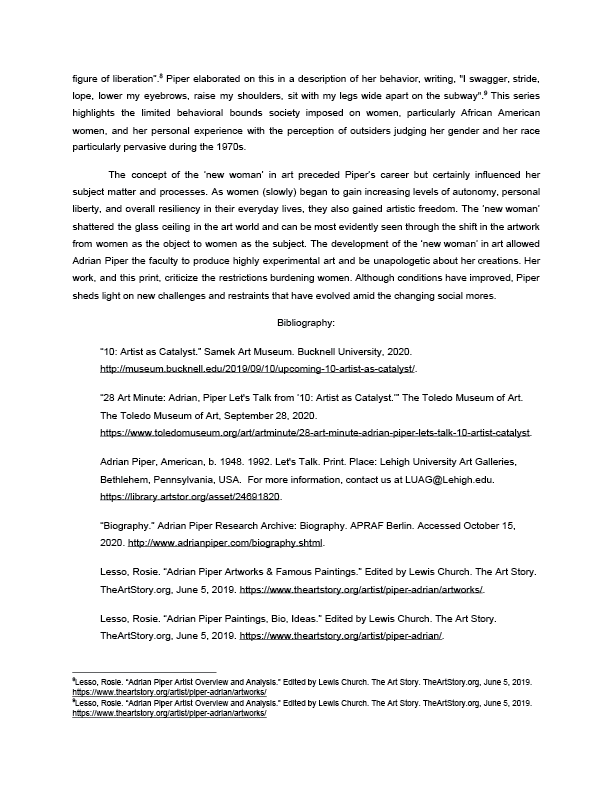

I always laugh at her long title “Let’s have a talk / to bring us closer / as close friends do: / come nearer; may I stroke your back?”
My guess is that some one donated the Artist as Catalyst portfolio to Lehigh.